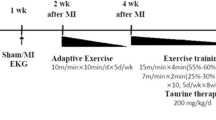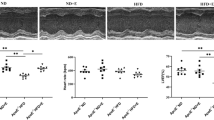Abstract
Although the role of vitamin D in various types of disorders such as cancer and diabetes has been well recognized, its relation to cardiovascular diseases still remains equivocal. The present study aims to investigate the interactive effects of aerobic-resistance training (ART) and vitamin D3 (VD3) on both cardiac fibrosis and heart functions considering TGF-β1/Smad2, 3 (transforming growth factor-β1/mothers against decapentaplegic homolog 2/3) signaling in the myocardial infarction (MI) model of rats. Fifty-six male Wistar rats were divided into 2 groups of sham (n = 8), and MI (n = 48). Then, MI rats were divided into six groups of VD3, ART, VD3+ART, Veh, Veh+ART, and sedentary MI. The animals received the related treatments for 8 weeks, and then their functional exercise capacity (FEC) and strength gain (SG) were estimated through exercise tests. Ejection fraction (EF%) and fractional shortening (FS%) and serum level of VD3 were measured by echocardiography and ELISA, respectively. Cardiac expressions of TGF-β1, Smad2/3, and collagen I/III were assessed by western blotting and fibrosis by Masson’s trichrome staining. The highest EF, parallel with the lowest expression of cardiac TGF-β1, Smad2/3, collagen I, and collagen III were observed in MI + VD3 (P = 0.021), MI + ART (P = 0.001), and MI + VD3 + ART (P < 0.001). Furthermore, similar to FS, the highest FEC and SG were related to the groups of MI + VD3 + ART and MI + ART compared to the MI group. In conclusion, our data indicate that concurrent vitamin D supplementation and ART, compared with monotherapy, successfully improve cardiac function and alleviate myocardial fibrosis via downregulating TGF-β1, Smad2/3 signaling, and also regulating collagen I and III expressions.





Similar content being viewed by others
Change history
13 March 2021
A Correction to this paper has been published: https://doi.org/10.1007/s13105-021-00795-z
References
Almeida SA, Claudio ER, Mengal V, Oliveira SG, Merlo E, Podratz PL, Gouvêa SA, Graceli JB, de Abreu GR (2014) Exercise training reduces cardiac dysfunction and remodeling in ovariectomized rats submitted to myocardial infarction. PLoS One 9:e115970. https://doi.org/10.1371/journal.pone.0115970
Babaei P, Damirchi A, Hoseini R (2015) The interaction effects of aerobic exercise training and vitamin D supplementation on plasma lipid profiles and insulin resistance in ovariectomized rats. J Exerc Nutr Biochem 19:173–182. https://doi.org/10.5717/jenb.2015.15070703
Bae S, Yalamarti B, Ke Q, Choudhury S, Yu H, Karumanchi SA, Kroeger P, Thadhani R, Kang PM (2011) Preventing progression of cardiac hypertrophy and development of heart failure by paricalcitol therapy in rats. Cardiovasc Res 91:632–639. https://doi.org/10.1093/cvr/cvr133
Bansal A, Dai Q, Chiao YA, Hakala KW, Zhang JQ, Weintraub ST, Lindsey ML (2010) Proteomic analysis reveals late exercise effects on cardiac remodeling following myocardial infarction. J Proteome 73:2041–2049. https://doi.org/10.1016/j.jprot.2010.06.009
Ding YF, Peng YR, Li J, Shen H, Shen MQ, Fang TH (2013) Gualou Xiebai Decoction prevents myocardial fibrosis by blocking TGF-beta/Smad signalling. J Pharm Pharmacol 65:1373–1381. https://doi.org/10.1111/jphp.12102
Dudnakova TV, Lakomkin VL, Tsyplenkova VG, Shekhonin BV, Shirinsky VP, Kapelko VI (2003) Alterations in myocardial ultrastructure and protein expression after a single injection of isoproterenol. Mol Cell Biochem 252:173–181. https://doi.org/10.1023/A:1025579624695
Feriani DJ, Coelho-Júnior HJ, de Oliveira J, Delbin MA, Mostarda CT, Dourado PMM, Caperuto ÉC, Irigoyen MCC, Rodrigues B (2018) Pyridostigmine improves the effects of resistance exercise training after myocardial infarction in rats. Front Physiol 9:53. https://doi.org/10.3389/fphys.2018.00053
Garza MA, Wason EA, Zhang JQ (2015) Cardiac remodeling and physical training post myocardial infarction. World J Cardiol 7:52–64. https://doi.org/10.4330/wjc.v7.i2.52
George JC, Liner A, Hoit BD (2010) Isoproterenol-induced myocardial injury: a systematic comparison of subcutaneous versus intraperitoneal delivery in a rat model. Echocardiography 27:716–721. https://doi.org/10.1111/j.1540-8175.2009.01107
Giallauria F, Galizia G, Lucci R, D’Agostino M, Vitelli A, Maresca L, Orio F, Vigorito C (2009) Favourable effects of exercise-based cardiac rehabilitation after acute myocardial infarction on left atrial remodeling. Int J Cardiol 136:300–306. https://doi.org/10.1016/j.ijcard.2008.05.026
Habooby NGSA, Yousif NG, Hadi NR, Al-Baghdadi JJ (2018) Vitamin D attenuates myocardial injury by reduces ERK phosphorylation induced by I/R in mice model. Curr Chemi Genomics Transl Med:12. https://doi.org/10.2174/2213988501812010027
Hoseini R, Damirchi A, Babaei P (2017) Vitamin D increases PPARγ expression and promotes beneficial effects of physical activity in metabolic syndrome. Nutrition 36:54–59. https://doi.org/10.1016/j.nut.2016.06.010
Ikeuchi M, Tsutsui H, Shiomi T, Matsusaka H, Matsushima S, Wen J, Kubota T, Takeshita A (2004) Inhibition of TGF-beta signaling exacerbates early cardiac dysfunction but prevents late remodeling after infarction. Cardiovasc Res 64:526–535. https://doi.org/10.1016/j.cardiores.2004.07.017
Jain M, Liao R, Ngoy S, Whittaker P, Apstein CS, Eberli FR (2000) Angiotensin II receptor blockade attenuates the deleterious effects of exercise training on post-MI ventricular remodelling in rats. Cardiovasc Res 46:66–72. https://doi.org/10.1016/s0008-6363(99)00429-0
Kalluri R, Weinberg RA (2009) The basics of epithelial-mesenchymal transition. J Clin Invest 119:1420–1428. https://doi.org/10.1172/jci39104
Kono K, Fujii H, Nakai K, Goto S, Kitazawa R, Kitazawa S, Shinohara M, Hirata M, Fukagawa M, Nishi S (2013) Anti-oxidative effect of vitamin D analog on incipient vascular lesion in non-obese type 2 diabetic rats. Am J Nephrol 37:167–174. https://doi.org/10.1159/000346808
Krstić J, Trivanović D, Mojsilović S, Santibanez JF (2015) Transforming growth factor-beta and oxidative stress interplay: implications in tumorigenesis and cancer progression. Oxidative Med Cell Longev 2015:654594–654515. https://doi.org/10.1155/2015/654594
Lai CC, Liu CP, Cheng PW, Lu PJ, Hsiao M, Lu WH, Sun GC, Liou JC, Tseng CJ (2016) Paricalcitol attenuates cardiac fibrosis and expression of endothelial cell transition markers in isoproterenol-induced cardiomyopathic rats. Crit Care Med 44:e866–e874. https://doi.org/10.1097/ccm.0000000000001736
Li X, Zhang ZL, Wang HF (2017) Fusaric acid (FA) protects heart failure induced by isoproterenol (ISP) in mice through fibrosis prevention via TGF-β1/SMADs and PI3K/AKT signaling pathways. Biomed Pharmacother 93:130–145. https://doi.org/10.1016/j.biopha.2017.06.002
Liao PH, Hsieh DJ, Kuo CH, Day CH, Shen CY, Lai CH, Chen RJ, Padma VV, Kuo WW, Huang CY (2015) Moderate exercise training attenuates aging-induced cardiac inflammation, hypertrophy and fibrosis injuries of rat hearts. Oncotarget 6:35383–35394. https://doi.org/10.18632/oncotarget.6168
Lobo Filho HG, Ferreira NL, Sousa RB, Carvalho ER, Lobo PL, Lobo Filho JG (2011) Experimental model of myocardial infarction induced by isoproterenol in rats. Rev Bras Cir Cardiovasc 26:469–476. https://doi.org/10.5935/1678-9741.20110024
Ma X, Fu Y, Xiao H, Song Y, Chen R, Shen J, An X, Shen Q, Li Z, Zhang Y (2015) Cardiac fibrosis alleviated by exercise training is AMPK-dependent. PLoS One 10:e0129971. https://doi.org/10.1371/journal.pone.0129971
Michos ED, Blumenthal RS (2007) Vitamin D supplementation and cardiovascular disease risk. Circulation 115:827–828. https://doi.org/10.1161/circulationaha.106.686238
Mozos I, Marginean O (2015) Links between vitamin D deficiency and cardiovascular diseases. Biomed Res Int 2015:109275–109212. https://doi.org/10.1155/2015/109275
Mukherjee D, Ghosh AK, Dutta M, Mitra E, Mallick S, Saha B, Reiter RJ, Bandyopadhyay D (2015) Mechanisms of isoproterenol-induced cardiac mitochondrial damage: protective actions of melatonin. J Pineal Res 58:275–290. https://doi.org/10.1111/jpi.12213
Park S, Nguyen NB, Pezhouman A, Ardehali R (2019) Cardiac fibrosis: potential therapeutic targets. Transl Res 209:121–137. https://doi.org/10.1016/j.trsl.2019.03.001
Patel R, Rizvi AA (2011) Vitamin D deficiency in patients with congestive heart failure: mechanisms, manifestations, and management. South Med J 104:325–330. https://doi.org/10.1097/SMJ.0b013e318213cf6b
Piek A, de Boer RA, Silljé HH (2016) The fibrosis-cell death axis in heart failure. Heart Fail Rev 21:199–211. https://doi.org/10.1007/s10741-016-9536-9
Rodriguez AJ, Mousa A, Ebeling PR, Scott D, de Courten B (2018) Effects of vitamin D supplementation on inflammatory markers in heart failure: a systematic review and meta-analysis of randomized controlled trials. Sci Rep 8:1169. https://doi.org/10.1038/s41598-018-19708-0
Sallam N, Laher I (2016) Exercise modulates oxidative stress and inflammation in aging and cardiovascular diseases. Oxidative Med Cell Longev 2016:7239639–7239632. https://doi.org/10.1155/2016/7239639
Seifi-Skishahr F, Damirchi A, Farjaminezhad M, Babaei P (2016) Physical training status determines oxidative stress and redox changes in response to an acute aerobic exercise. Biochem Res Int 2016:3757623–3757629. https://doi.org/10.1155/2016/3757623
Takeda M, Yamashita T, Sasaki N, Nakajima K, Kita T, Shinohara M, Ishida T, Hirata K (2010) Oral administration of an active form of vitamin D3 (calcitriol) decreases atherosclerosis in mice by inducing regulatory T cells and immature dendritic cells with tolerogenic functions. Arterioscler Thromb Vasc Biol 30:2495–2503. https://doi.org/10.1161/atvbaha.110.215459
Tousi SMTR, Faghihi M, Nobakht M, Molazem M, Kalantari E, Azar AD, Aboutaleb N (2016) Improvement of heart failure by human amniotic mesenchymal stromal cell transplantation in rats. J Tehran Univ Heart Cent 11:123
van Meeteren LA, Goumans M-J, ten Dijke P (2013) TGF-β and cardiovascular disorders. In: TGF-β in Human Disease. Springer, Berlin, pp 297–322
Wang L, Manson JE, Song Y, Sesso HD (2010) Systematic review: vitamin D and calcium supplementation in prevention of cardiovascular events. Ann Intern Med 152:315–323. https://doi.org/10.7326/0003-4819-152-5-201003020-00010
Xiao L, He H, Ma L, Da M, Cheng S, Duan Y, Wang Q, Wu H, Song X, Duan W, Tian Z, Hou Y (2017) Effects of miR-29a and miR-101a expression on myocardial interstitial collagen generation after aerobic exercise in myocardial-infarcted rats. Arch Med Res 48:27–34. https://doi.org/10.1016/j.arcmed.2017.01.006
Yuan W, Pan W, Kong J, Zheng W, Szeto FL, Wong KE, Cohen R, Klopot A, Zhang Z, Li YC (2007) 1, 25-dihydroxyvitamin D3 suppresses renin gene transcription by blocking the activity of the cyclic AMP response element in the renin gene promoter. J Biol Chem 282:29821–29830. https://doi.org/10.1074/jbc.M705495200
Author information
Authors and Affiliations
Corresponding author
Ethics declarations
Animals used in these experiments were treated in accordance with the National Institutes of Health Guide for the Care and Use of Laboratory Animals, and the research protocol was approved by the ethics committee of Guilan University of Medical Sciences (IR.GUMS.REC.1398.046).
Conflict of interest
The authors declare that they have no conflicts of interest.
Additional information
Publisher’s note
Springer Nature remains neutral with regard to jurisdictional claims in published maps and institutional affiliations.
Key points
• Concurrent aerobic-resistance training and VD3 supplementation are more efficient than exercise training alone in alleviating cardiac fibrosis
• Concurrent aerobic-resistance training and VD3 supplementation reduce cardiac fibrosis through downregulating TGF-β/Smad signaling
• Concurrent aerobic-resistance training and VD3 supplementation are better than monotherapy in improving EF and FS
Rights and permissions
About this article
Cite this article
Mehdipoor, M., Damirchi, A., Razavi Tousi, S.M.T. et al. Concurrent vitamin D supplementation and exercise training improve cardiac fibrosis via TGF-β/Smad signaling in myocardial infarction model of rats. J Physiol Biochem 77, 75–84 (2021). https://doi.org/10.1007/s13105-020-00778-6
Received:
Accepted:
Published:
Issue Date:
DOI: https://doi.org/10.1007/s13105-020-00778-6




